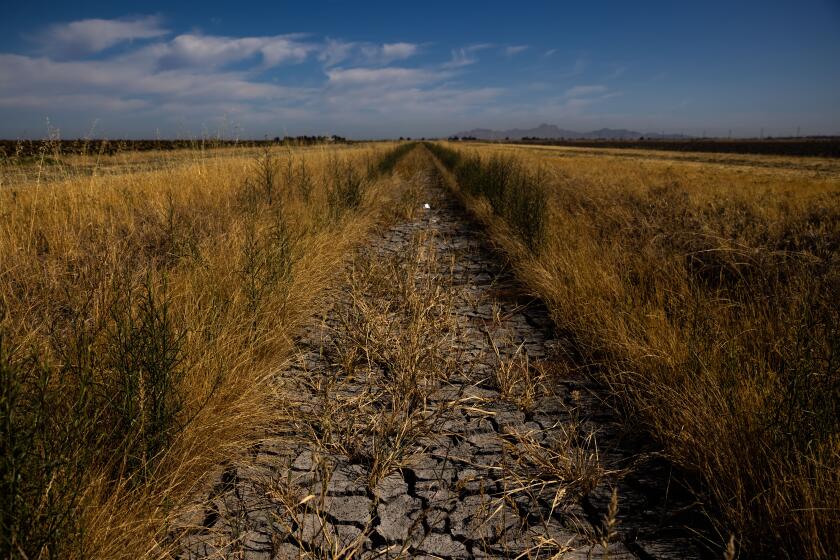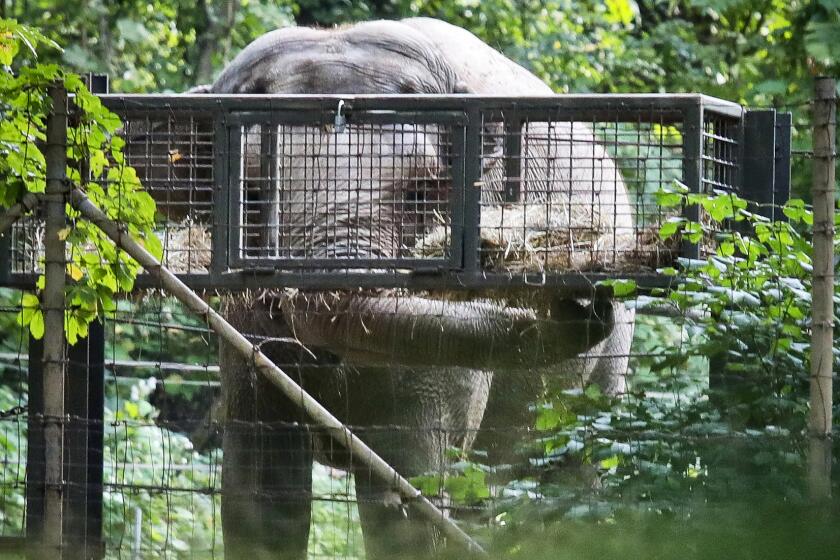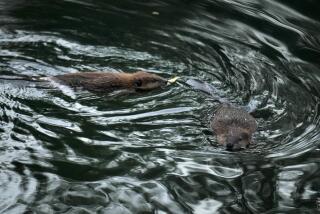Op-Ed: Want to fight climate change and drought at the same time? Bring back beavers

Millions of highly skilled environmental engineers stand ready to make our continent more resilient to climate change. They restore wetlands that absorb carbon, store water, filter pollution and clean and cool waters for salmon and trout. They are recognized around the world for helping to reduce wildfire risk. Scientists have valued their environmental services at close to $179,000 per square mile annually.
And they work for free.
Our ally in mitigating and adapting to climate change across the West could be a paddle-tailed rodent: the North American beaver.
The added heat from global warming has made drought-stricken lands extra-dry. It will take more precipitation than usual to end it.
There’s a strong consensus among scientists and environmental managers on the benefits of working with beavers to protect our natural environments. Beavers can help us continue to live on, work with and enjoy our Western landscape. As ecosystem engineers, they build dams and dig canals to escape predators. Their manipulation of plants for food and building materials produces wide-ranging environmental gains.
Yet despite beavers’ ecosystem benefits, we have long pushed them out of their homes. When the European-American fur trade killed hundreds of millions of beavers, it destroyed the engine that built and maintained North American wetlands. California alone has lost an estimated 90% of its wetland area. Humans continue to tear down beavers’ dams and lodges when they get in our way.
Rather than chase beavers off, it is time to invite them back.
Watershed scientists and state and federal land managers can identify the thousands of streams most suited to beavers. Simple steps can help bring them to watersheds in need — whether that means helping restore river environments to attract dispersing juvenile beavers from existing nearby populations, or reintroducing beavers to locations where they had thrived before the fur trade and habitat degradation destroyed them as well as their homes.
Beavers can then set in motion protective natural processes. Their dams and canals slow the flow of streams and rivers, spreading water across the floodplain. Once slowed, the water loses its ability to carry sand, silt and gravel, so these materials accumulate. The wet ground and regular sediment deposits make fertile conditions for vegetation that has evolved with beavers and is more productive when regularly chewed. All of this builds and maintains wetlands.
This nature-based restoration can in turn help stave off the worst effects of climate change that are warming streams, deepening droughts and fueling wildfires. These threats harm native fish and wildlife in our communities while draining billions of dollars from our economies.
A new case in California will test the theory that captive elephants should be allowed to petition for their liberty.
Riverine wetlands rebuilt by beavers can counteract rising temperatures, nourishing vegetation that stores carbon and benefiting sensitive species including steelhead trout. Spreading water across the floodplain creates a network of firebreaks — gaps in combustible vegetation that can stop or slow wildfires. And beaver wetlands help combat drought because their dams raise water levels so the ground stores water like a sponge, percolating out in drier seasons, which keeps streams flowing instead of going dry.
As part of a team of state, federal and university researchers, we tested the capacity of beavers along an eastern Oregon creek so eroded from years of poor management that the water ran many feet below the surrounding terrain. The erosion led to dried-out floodplains, dead stream-side vegetation and a self-sustaining cycle of drying and degradation in the channel.
Fixing the creek would require slowing that water down, piling it up to reconnect the channel to its floodplain. This would be a big ask for beavers on their own, so we helped. We hand-built structures to mimic beaver dams to begin slowing and spreading the flow.
This work attracted the first beavers from other environments. In just a few years, more beavers found the spot and assumed the maintenance. Building on our initial efforts, they transformed logs, mud and sticks into structures that spanned the valley and spread the water across many small branching channels, canals and ponds. Willows and other stream-side vegetation emerged. Water soaked the ground in storage that gradually filtered back out, offsetting dry spells.
Stream-side communities might worry that letting a wild dam builder loose might spur flooding that could damage property. But beavers are creatures of habit, meaning we can predict which locations have the lowest potential for human conflicts and greatest potential for environmental benefits. We can entice beavers to remote areas such as millions of acres of national forest and other federal and state lands. And we have tools to prevent beavers’ work from damaging property, such as devices that keep beaver ponds at safe levels, fencing or paint to protect trees and screening to ensure drainage systems are not plugged.
The work is also relatively cheap. The main costs of beaver-based stream restoration involve helping them get a foothold by starting restoration work ourselves and, where necessary, transporting beavers to the right natural site. This approach typically costs thousands of dollars per mile, not the millions per mile we often spend on infrastructure solutions.
This solution also requires not destroying our population of environmental heroes. Last year alone, approximately 25,000 beavers were killed by wildlife control officers in response to people’s complaints and requests to protect their property. Imagine the value to communities of promoting nonlethal options instead, such as adapting the environment for coexistence with beavers or, when that’s not an option, moving them to less conflict-prone locations.
The job is enormous, but so is the capacity of beavers to help. Modest funding for beaver restoration was added to California’s budget this year. Groups that protect wildlife, fisheries and wetlands should join forces across the West to make beavers integral to a coordinated climate change response.
Chris Jordan is mathematical biology and systems monitoring program manager at NOAA Fisheries’ Northwest Fisheries Science Center. Emily Fairfax is an assistant professor of environmental science and resource management at Cal State Channel Islands.
More to Read
A cure for the common opinion
Get thought-provoking perspectives with our weekly newsletter.
You may occasionally receive promotional content from the Los Angeles Times.








